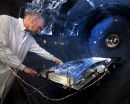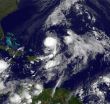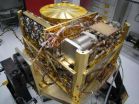(Press-News.org) The sudden death of bee colonies since late 2006 across North America has stumped scientists. But today, researchers may have a greater understanding of the mysterious colony collapse disorder, said a Texas Tech University biologist.
Shan Bilimoria, a professor and molecular virologist, said the bees may be taking a one-two punch from both an insect virus and a fungus, which may be causing bees to die off by the billions.
Bilimoria is part of a team of researchers searching for the cause of the collapse. Led by research professor Jerry Bromenshenk from the University of Montana in Missoula, the group also includes virologists and chemists from the U.S. Army Edgewood Chemical Biological Center and the Instituto de Ecologica AC in Mexico.
Their study was published this week in the peer-reviewed journal PLoS ONE.
"At this stage, the study is showing an association of death rates of the bees with the virus and fungus present," Bilimoria said. "Our contribution to this study confirms association. But even that doesn't prove cause and effect. Not just yet."
The mysterious colony deaths have caused major concern with scientists since much of agriculture depends on bees to pollinate crops.
To discover what might be attacking bee colonies, the team ground up dead bees that had succumbed to colony collapse disorder. Using analytical equipment, researchers discovered through spectroscopic analysis evidence of a moth virus called insect iridescent virus (IIV) 6 and a fungal parasite called Nosema.
The insect virus is closely related to another virus that wiped out bee populations 20 years ago in India, he said. Also, unlike previous research that found the deaths may be caused by a virus with RNA, the IIV 6 contains DNA.
"Our DNA discovery puts this field in a whole new direction," he said.
Bilimoria said Texas Tech supplied the virus material for the experiments and were tested on bees with the fungus. Though an association between exposure and death was found, scientists don't yet know if the two pathogens cause CCD or whether CCD colonies are more likely to succumb to the two pathogens.
"To prove cause and effect, we will have to isolate the virus and fungus from bee colony, and then reinfect with same virus and fungus," Bilimoria said.
In the next part of the research project, Bilimoria will work to isolate the virus from infected bees.
"Once we isolate and identify the virus, we will have a way of monitoring it," he said. "It is easier to fight the problem if we know what the culprit is."
INFORMATION:
For a copy of a frequently-asked-questions sheet, please contact John Davis.
CONTACT: Shan Bilimoria, professor, Department of Biological Sciences, Texas Tech University, (806) 742-2710 ext. 287, (806) 239-7251 cell, or shan.bilimoria@ttu.edu
END
COLUMBIA, Mo. – Diagnostic ultrasounds are the most widely used medical tests in the world. Though the technology is more than 50 years old, scientists continue to discover new uses for it, ranging from more targeted cancer treatments to liposuction. As the technology becomes more complex, a sonographer's skill level is even more important. Now, researchers at the University of Missouri may have found one of the keys to becoming a successful sonographer: spatial ability.
Doug Clem, clinical assistant professor of MU's diagnostic ultrasound program in the MU School ...
NASA's James Webb Space Telescope continues to make significant progress, successfully completing a series of sunshield vent tests that validate the telescope's sunshield design.
"While adequate venting is a design consideration for all spaceflight hardware, this was a particularly unique challenge for the sunshield given the large volume of trapped air in the membrane system at launch," said Keith Parrish, Webb telescope sunshield manager at NASA's Goddard Space Flight Center in Greenbelt, Md. "From the beginning of its development venting features have been a critical ...
A woman's race/ethnicity and socioeconomic status impact whether health care providers recommend one of the most highly effective forms of contraception, a UCSF study confirms. The results also indicate that the interaction of both factors plays a role in clinicians' decisions.
Recommendations by health care providers previously have been found to vary by patients' race and socioeconomic status, contributing to health disparities, according to the researchers. The team investigated the effect of these factors on recommendations for contraception.
Study results appear ...
When people are rejected by peers, they often lash out. In children, that aggression occasionally takes horrifying directions, leading to school shootings or other deadly acts. Researchers in the Netherlands found that some children are more likely than others to lash out in response to acute peer rejection: children who already feel like outcasts.
"It was inspired by the fact that we had these school shootings and wondered what the most important feature of these kids could be," says Albert Reijntjes of Utrecht University, who cowrote the study with five other psychological ...
RICHMOND, Va. (Oct. 8, 2010) – An international team of researchers has discovered a new class of highly electronegative chemical species called hyperhalogens, which use superhalogens as building blocks around a metal atom. The new chemical species may have application in many industries.
Researchers from Virginia Commonwealth University, McNeese State University in Lake Charles, La., and the University of Konstanz in Germany report their discovery in the Oct. 6 international chemistry journal Angewandte Chemie International Edition. The journal designated the paper as ...
At 11 a.m. EDT on Oct. 8, Otto strengthened into a hurricane, becoming the eighth hurricane of the Atlantic Ocean season. NASA's Aqua satellite and the NOAA GOES-13 satellite captured images of Otto as he intensified.
Otto had maximum sustained winds near 75 mph, and the National Hurricane Center in Miami, Fla. noted that some strengthening is possible before it weakens on Saturday, Oct. 9. Otto was located about 445 miles south of Bermuda near 25.9 North and 64.0 West. It was moving east-northeast near 17 mph, and had a minimum central pressure of 979 millibars.
On ...
The Sample Analysis at Mars (SAM) instrument suite has completed assembly at NASA's Goddard Space Flight Center in Greenbelt, Md., and is nearly ready for a December delivery to NASA's Jet Propulsion Laboratory (JPL), Pasadena, Calif., where it will be joined to the Curiosity rover. SAM and Curiosity are set to fly on the on the upcoming Mars Science Laboratory (MSL) rover mission scheduled for launch in the fall of 2011.
SAM will become an automated, mobile laboratory as it is carried across Mars by the rover when the mission arrives at the Red Planet in 2012. Together ...
DALLAS – Oct. 12, 2010 – Researchers at UT Southwestern Medical Center have created an experimental vaccine against beta-amyloid, the small protein that forms plaques in the brain and is believed to contribute to the development of Alzheimer's disease.
Compared with similar so-called DNA vaccines that the UT Southwestern researchers tested in an animal study, the new experimental vaccine stimulated more than 10 times as many antibodies that bind to and eliminate beta-amyloid. The results appeared in the journal Vaccine.
Future studies will focus on determining the ...
Researchers at the University of Illinois at Chicago College of Medicine have found how gene expression that may contribute to drug resistance is ramped up in unusual types of breast tumors. Their findings may offer new therapy targets.
The study is published in the Oct. 8 issue of the Journal of Biological Chemistry, where it is designated a paper of the week.
Approximately 70 percent of breast cancers express the estrogen receptor. These "ER-positive" tumors usually respond to hormone-related therapies, such as tamoxifen or aromatase inhibitors. But not always.
"We ...
WASHINGTON, Oct. 9, 2010 — Help may be on the way for millions of people on the East Coast bugged out about the invasion of stink bugs. Scientists have reported a key advance in efforts to develop the first commercial repellent for stinkbugs, which are emerging as a major nuisance to homeowners and a devastating pest to some farm crops. They identified a natural substance in a fungus that infects a common weed and found that it shows potential as the first stinkbug repellent. Their study appeared in ACS' bi-weekly Journal of Agricultural and Food Chemistry.
Hiromitsu ...



